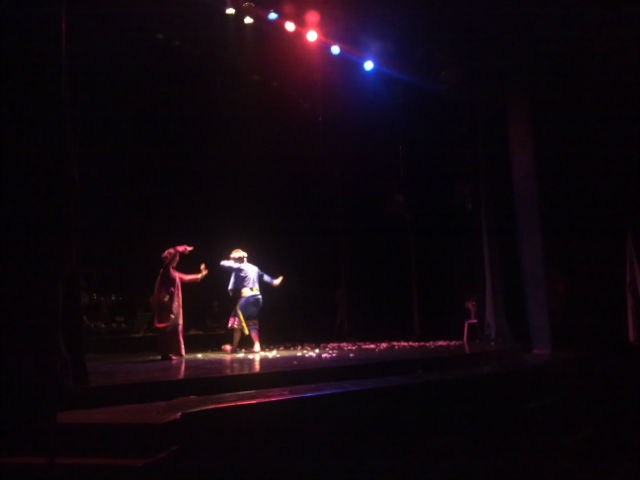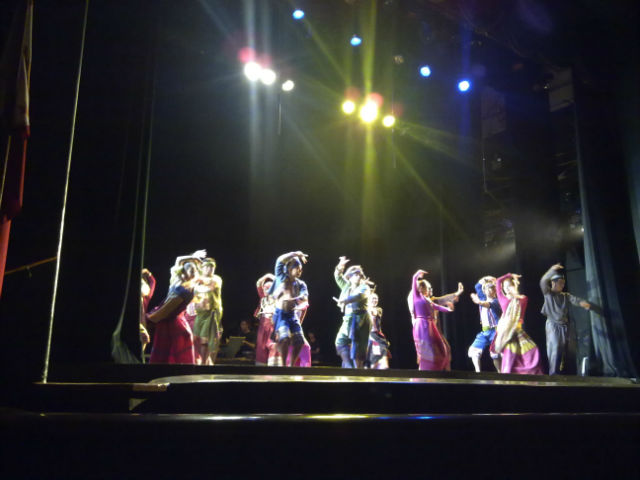Filtered by: Lifestyle
Lifestyle
Theater review: Romeo and Juliet goes Pinoy in 'Sintang Dalisay'
Text and photos by CARMELA G. LAPEÑA, GMA NEWS

Jamila and Rashiddin in "Sintang Dalisay"
The story of Romeo and Juliet is a favorite among teenagers. A "you and me against the world" love story that ends tragically, it's no surprise that this is still one of Shakespeare's most popular plays. But as language continues to evolve, much of the Bard's wit is lost on today's audiences, particularly the kids who only read when they absolutely must.
With the tough competition of the Internet and the generally short attention span of young audiences, staging a two-hour play is no small challenge.
But Tanghalang Ateneo's "Sintang Dalisay" is no small play, and their staging of a Filipino Romeo and Juliet gave its audience an experience more entertaining than any app, YouTube clip, or video game.
At the Far Eastern University Auditorium last July 23, the seats were filled with students clad in their green and yellow uniforms. As with many on-campus activities, it appeared they had been required to attend. But they were captivated from start to finish, enthusiastically clapping and laughing at all the right parts, and some wrong ones, too.

Colorful costumes by National Artist Salvador Bernal
Based on G.D. Roke's 1901 "Ang Sintang Dalisay ni Julieta at Romeo," and Rolando Tinio's translation of Shakespeare's play, the adaptation is set in an imaginary Muslim community called Sampurna.
Since most were already familiar with Romeo and Juliet, they had no trouble following the plot. The handsome Rashiddin Mustapha and the lovely Jamila Kalimuddin are caught between their family's hatred for each other. They ask an imam to marry them in secret, but their brief happiness ends when Rashiddin kills a Kalimuddin, who killed a Rashiddin. Rashiddin is exiled to Dapitan, and a suicidal Jamila asks the imam for poison. He gives her a sleeping potion and writes to Rashiddin, but the letter is lost along the way and the tale ends with both lovers dead and the families reconciled.
The energetic crowd chuckled at clever one-liners from the feuding clans, but they also giggled uncontrollably during the entire love scene, which could have been a beautifully sad dance.

Igal dance movements mimic nature.
One uniquely Filipino feature of this production is the igal, the traditional dance of the Sama people. The dance mimics nature, explained Matthew Santamaria, who drew the igal movement patterns from master teachers from Tabawan in South Ubian, Tawi-Tawi province.
Before the play, Santamaria demonstrated a few of the movements, such as one where the arms flowed like waves, and another where they swayed like trees. The actors moved to music from Kulintang Ateneo and the University of the Philippines' Kontemporaryong Gamelan Pilipino (Kontra-GaPi).
The actors gave strong performances, the dances were obviously well-rehearsed, and the language was just the right mix of poetic and popular, with funny quips smoothly delivered without interrupting the play's rhythm. It was a splendid production, and the costumes designed by National Artist Salvador Bernal created a visual feast with the shimmering golds and vivid hues.
The applause at the end was wild, complete with cheers and whistles. After the play, director Ricardo Abad encouraged the students to ask questions, which ranged from inquiries about the actors' relationship status to serious comments on the performance.
The students were rowdy, but in this case no teachers were forcing them to quiet down. As for the cast and crew, it was the sort of reception they welcomed. As Santamaria put it, "this is how theater should be." –KG, GMA News
"Sintang Dalisay" is being staged this August at the Rizal Mini Theater in Ateneo de Manila University. Playdates are Aug. 14-18, 22-25 (7 p.m.); Aug. 18, 25 (2 p.m.). For details and re-booking concerns (for those affected by the show cancellations), contact Reggie Aquitaña at 0922-8679716.
More Videos
Most Popular




